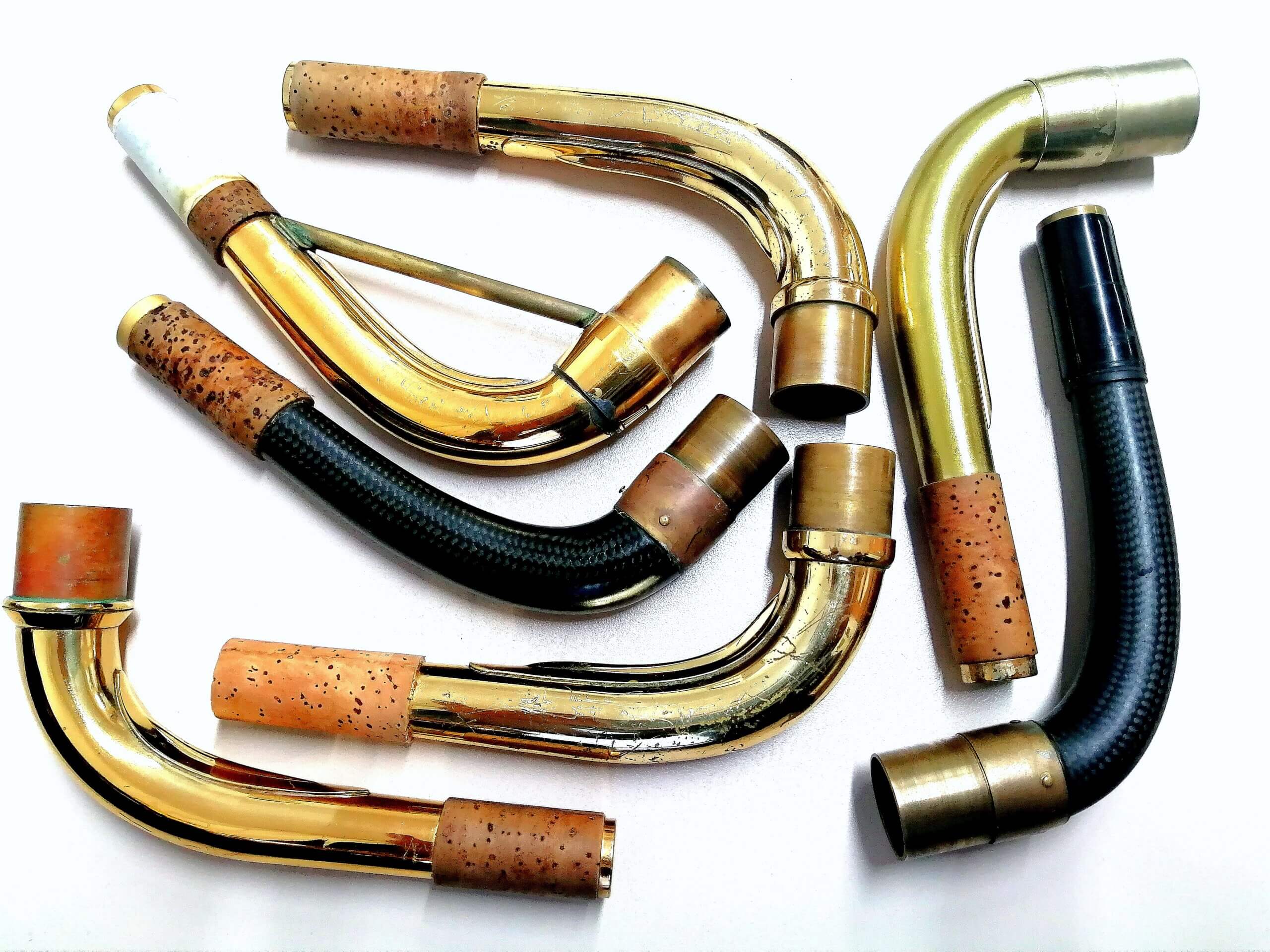
Some necks for baritone saxophone (Photo: Joan MF)
Usually, when we talk about the technical and mechanical matters, we refer to the tube of the instrument or, on the other hand, to the mouthpieces, reeds and ligatures. More and more often, we become aware of how important are the necks. Here I tell my experience to you.
First of all, I invited two baritonists of classical/contemporary music I respect a lot to participate in this post: Daniel Miguel, from Kebyart (CAT) and Jay Byrnes, from Nexas Quartet (AUS). Thank you so much for your contributions, my friends. Your experience and thoughts complement this post very well.
I suppose that many saxophonists (no just baritone players) agree that the parts of the instrument closest to the focus of production of sound will decisively influence the resulting sound. This is why we saxophonists talk so much about mouthpieces, ligatures, reeds… and necks too.
Such is the influence of this piece of tube with a “L-shape”? Yes. A lot! A good neck can turn a normal tube into a good instrument. When you buy a new baritone, don’t hesitate to compare how your favorite tube works with the necks of the other saxophones you rejected. You will maybe be surprised.
I say that because this had already happened to me several times. The best body (in terms of quality of sound in harmonics, solid mechanism, etc.) improved its performances with another neck of the same model of baritone. Although it may seem quite similar, each model has its own design and structure that makes a more homogeneous sound. I don’t recommend to exchange models. However, you can always find an exception.
Characteristics of Necks
Why is a neck so important? How does it affect the instrument?
As I have said before, we baritonists usually talk about other elements of our set-up. However, necks are a very important part of our instrument.
The neck performance mainly affects the intonation and colour palette of the baritone saxophone. This is due to the angle, the inner design and the material which it is made.
The neck angle hits the air column speed by modifying the intonation and sound projection. Adolphe Sax already saw the acoustic performance of curved tubes and other manufacturers also studied this later. With Jorge Marqués, founder of Carbonissimo, we saw the influence of intonation and sound projection by analyzing the different angles of my other necks. Furthermore, we classified different types of angles according to their models and fit perfectly other baritones.
Neck design is very important. The thickness and inner coning affect the amplitude of the sound and dynamics palette and, on the other hand, in the flow of air control, influencing the intonation, response and projection of sound.
All has been said up to this point, you can notice it with standard brass necks for baritone saxophone. If you are looking for something better (yes, better!), we should mention the building materials. For this reason, I made a separate paragraph. If the baritone is your first or second saxophone, I think that it’s worth investing a little more money in acquiring a “premium” neck.
Materials
In recent years, the brands have seen that saxophones improved their performances by lacquering or making the necks with “fine” materials. Gold, silver or copper and other alloys (as pink gold or red brass) have a higher density and provide more timber richness.
Despite products for baritone put always into market later than other saxophones (lower sales and market volume is always the brands’ excuse), we can finally find an increasing variety of necks.
The first “premium” necks for baritone saxophone I tried were solid silver and gold lacquered. Although the first ones had a more homogeneous and richer sound, I chose the second ones. Gold lacquered necks gave me a compact sound and the impression of more projection and free blowing. Furthermore, I felt a better response.
Later, Jorge Marqués let me discover the amazing acoustic properties of the carbon fiber. The lower density of this material (much less than brass) gives advantages in terms of efficiency of production and projection of sound. All this is highly demanded for baritonists in ensembles, bands and orchestras.
First time I blew into a carbon fiber prototype, I really hallucinated with the result. I missed the sound coloring of my gold lacquered neck but response, homogeneity of registers and stability of sound in extreme dynamics clearly exceed mine. We improved the intonation of the treble register and sound richness until reaching the present Carbonissimo necks line.
Necks for Baritone Saxophone. Daniel Miguel

Daniel Miguel by Igor Studio
I really enjoyed the time that Daniel Miguel studied at the Conservatory of Music of Reus. Now, I love to see his extraordinary career with the baritone saxophone.
Here is his experience with necks:
The neck is a very important part in the production of sound, especially in the baritone saxophone. Since it has no mechanism, the waves find a clean place to reverberate, to “sound”. Thus, we should look for a neck that interacts well with the body of the saxophone.
I played a Selmer Series III baritone saxophone with a gold lacquered neck for years. In my opinion, the Series III is a saxophone that needs the direction and the focused punch of sound of a golden neck.
Some years ago, I was testing some baritones Series II in Paris. Experimenting, I noticed that Series III necks worked much better in the Series II saxophones. This combination (mixing both worlds!) produced a richer sound, resonated much better and improved the general tuning of the tube. Among all those necks, the solid silver ones were the most balanced.
Silver neck gave the homogeneity of registers and sound depth to the Series II baritone, a mellower and stronger instrument. Precisely, I was looking for this then. What is important is that the choice of a material is up to the affinity to oneself, the main instrument.
Now, I am playing with the same model of saxophone and neck. My current neck is a solid silver rose gold plated one. For me, pink gold adds the best from both worlds: a homogeneity and depth of sound plus an extra of directionality that make me feel extremely comfortable.
Necks for Baritone Saxophone. Jay Byrnes

Jay Byrnes
Jay Byrnes is quite a reference in the baritone saxophone, not only in Australia. We have known each other for many years (social media also have a positive side) and have met some times. His enthusiasm is contagious.
This is his experience:
I have had some great experiences exploring with different necks on my Yanagisawa baritone saxophones.
I first started with a standard bronze neck on a B992, before quickly moving to a solid silver. I found the solid silver much more resistant but a clarity of tone and eveness over the whole range convinced me to stick with it. When I purchased my next B992 I ordered it with a gold plate bronze neck. I loved this neck, it was very special with an even intonation and a lovely sparkle to the tone (I sold it to a colleague and regret that decision).
I then moved to the BW01S sax. And got 2 necks with it. These necks were the new design from Yanagisawa that have a less open sound but much more focus and control. The two necks were a brass silver plate and a solid silver rose gold plated. The silver plate has a stunning focus and brilliance but lacks the tonal depth of the silver plate. It does however have much more flexibility and enables for a variety of tone colours. The solid silver has the most glorious warmth and roundness of tone, but is very resistant. They are both fabulous and I move between them often.
For me I don’t notice the differences between the necks when recording. For the audience I suspect the difference is barely noticeable if at all. But they give me a huge internal difference that makes me express differently. The change in resistance and tone feels different and therefore I perform differently. I always suggest exploring these possibilities.
—
Were you thinking about changing the neck of your baritone? Do you have a clearer image after reading these examples? If yes, as I always say, take your time to try them. Each one of us blows different, has his/her repertoire and his/her professional goals and purposes with the baritone saxophone.
Don’t hesitate to contact me if you need some individual advice about this or any other subject about the baritone saxophone.
Joan Martí-Frasquier
Barcelona, January 2025





